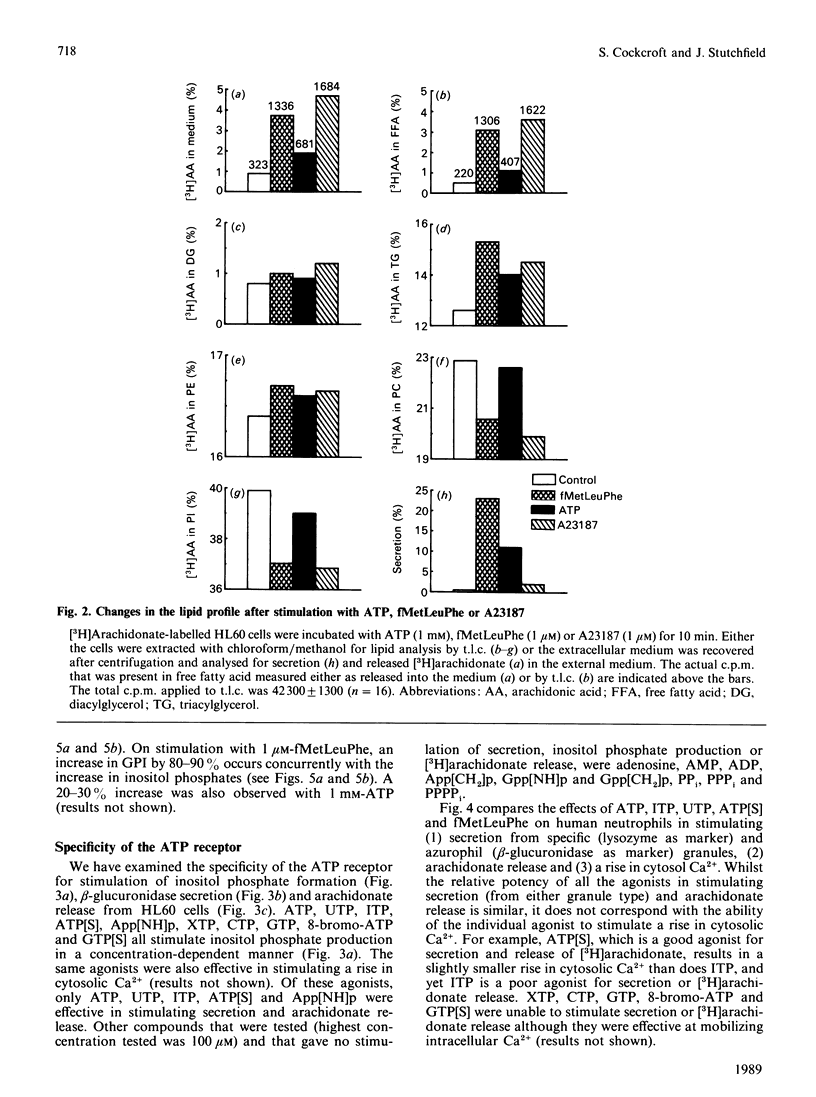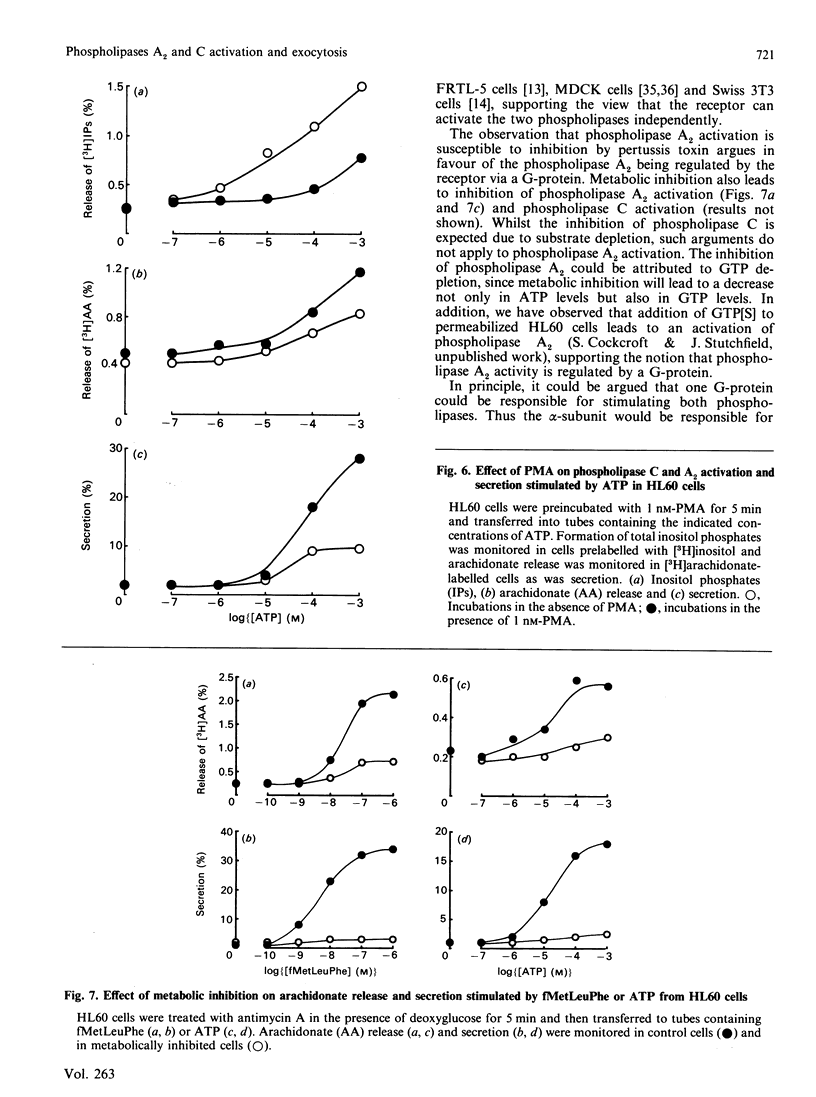Abstract
The relationship between phospholipase A2 and C activation and secretion was investigated in intact human neutrophils and differentiated HL60 cells. Activation by either ATP or fMetLeuPhe leads to [3H]arachidonic acid release into the external medium from prelabelled cells. This response was inhibited when the cells were pretreated with pertussis toxin. When the [3H]arachidonic acid-labelled cells were stimulated with fMetLeuPhe, ATP or Ca2+ ionophore A23187, and the lipids analysed by t.l.c., the increase in free fatty acid was accompanied by decreases in label from phosphatidylinositol and phosphatidylcholine. Moreover, incorporation of label into triacylglycerol and to a lesser extent phosphatidylethanolamine was evident. Activation of secretion was evident with ATP and fMetLeuPhe but not with A23187. The pharmacological specificity of the ATP receptor in HL60 cells was investigated by measuring secretion of beta-glucuronidase, formation of inositol phosphatases and release of [3H]arachidonic acid. External addition of ATP, UTP, ITP, adenosine 5'-[gamma-thio]triphosphate (ATP[S]), adenosine 5'-[beta gamma-imido]triphosphate (App[NH]p), XTP, CTP, GTP, 8-bromo-ATP and guanosine 5'-[gamma-thio]triphosphate (GTP[S]) to intact HL60 cells stimulated inositol phosphate production, but only the first five nucleotides were effective at stimulating secretion or [3H]arachidonic acid release. In human neutrophils, addition of ATP, ITP, UTP and ATP[S] also stimulated secretion from specific and azurophilic granules, and this was accompanied by increases in cytosolic Ca2+ and in [3H]arachidonic acid release. The addition of phorbol 12-myristate 13-acetate (PMA; 1 nM) prior to the addition of either fMetLeuPhe or ATP led to inhibition of phospholipase C activity. In contrast, this had no effect on phospholipase A2 activation, whilst secretion was potentiated. Phospholipase A2 activation by either agonist was dependent on an intact cell metabolism, as was secretion. It is concluded that (1) activation of phospholipase C does not always lead to activation of phospholipase A2, (2) phospholipase A2 is coupled to the receptor independently of phospholipase C via a pertussis-toxin-sensitive G-protein and (3) for secretion to take place, the receptor has to activate both phospholipases C and A2.
Full text
PDF








Selected References
These references are in PubMed. This may not be the complete list of references from this article.
- Allan D., Cockcroft S. A modified procedure for thin-layer chromatography of phospholipids. J Lipid Res. 1982 Dec;23(9):1373–1374. [PubMed] [Google Scholar]
- Balsinde J., Diez E., Schüller A., Mollinedo F. Phospholipase A2 activity in resting and activated human neutrophils. Substrate specificity, pH dependence, and subcellular localization. J Biol Chem. 1988 Feb 5;263(4):1929–1936. [PubMed] [Google Scholar]
- Barrowman M. M., Cockcroft S., Gomperts B. D. Differential control of azurophilic and specific granule exocytosis in Sendai-virus-permeabilized rabbit neutrophils. J Physiol. 1987 Feb;383:115–124. doi: 10.1113/jphysiol.1987.sp016399. [DOI] [PMC free article] [PubMed] [Google Scholar]
- Barrowman M. M., Cockcroft S., Gomperts B. D. Two roles for guanine nucleotides in the stimulus-secretion sequence of neutrophils. Nature. 1986 Feb 6;319(6053):504–507. doi: 10.1038/319504a0. [DOI] [PubMed] [Google Scholar]
- Bell R. L., Kennerly D. A., Stanford N., Majerus P. W. Diglyceride lipase: a pathway for arachidonate release from human platelets. Proc Natl Acad Sci U S A. 1979 Jul;76(7):3238–3241. doi: 10.1073/pnas.76.7.3238. [DOI] [PMC free article] [PubMed] [Google Scholar]
- Bokoch G. M., Gilman A. G. Inhibition of receptor-mediated release of arachidonic acid by pertussis toxin. Cell. 1984 Dec;39(2 Pt 1):301–308. doi: 10.1016/0092-8674(84)90008-4. [DOI] [PubMed] [Google Scholar]
- Burch R. M., Axelrod J. Dissociation of bradykinin-induced prostaglandin formation from phosphatidylinositol turnover in Swiss 3T3 fibroblasts: evidence for G protein regulation of phospholipase A2. Proc Natl Acad Sci U S A. 1987 Sep;84(18):6374–6378. doi: 10.1073/pnas.84.18.6374. [DOI] [PMC free article] [PubMed] [Google Scholar]
- Burch R. M., Luini A., Axelrod J. Phospholipase A2 and phospholipase C are activated by distinct GTP-binding proteins in response to alpha 1-adrenergic stimulation in FRTL5 thyroid cells. Proc Natl Acad Sci U S A. 1986 Oct;83(19):7201–7205. doi: 10.1073/pnas.83.19.7201. [DOI] [PMC free article] [PubMed] [Google Scholar]
- Cockcroft S. Ca2+-dependent conversion of phosphatidylinositol to phosphatidate in neutrophils stimulated with fMet-Leu-Phe or ionophore A23187. Biochim Biophys Acta. 1984 Aug 15;795(1):37–46. doi: 10.1016/0005-2760(84)90102-4. [DOI] [PubMed] [Google Scholar]
- Cockcroft S., Gomperts B. D. Role of guanine nucleotide binding protein in the activation of polyphosphoinositide phosphodiesterase. Nature. 1985 Apr 11;314(6011):534–536. doi: 10.1038/314534a0. [DOI] [PubMed] [Google Scholar]
- Cockcroft S., Howell T. W., Gomperts B. D. Two G-proteins act in series to control stimulus-secretion coupling in mast cells: use of neomycin to distinguish between G-proteins controlling polyphosphoinositide phosphodiesterase and exocytosis. J Cell Biol. 1987 Dec;105(6 Pt 1):2745–2750. doi: 10.1083/jcb.105.6.2745. [DOI] [PMC free article] [PubMed] [Google Scholar]
- Cockcroft S., Stutchfield J. ATP stimulates secretion in human neutrophils and HL60 cells via a pertussis toxin-sensitive guanine nucleotide-binding protein coupled to phospholipase C. FEBS Lett. 1989 Mar 13;245(1-2):25–29. doi: 10.1016/0014-5793(89)80184-x. [DOI] [PubMed] [Google Scholar]
- Cockcroft S., Stutchfield J. Effect of pertussis toxin and neomycin on G-protein-regulated polyphosphoinositide phosphodiesterase. A comparison between HL60 membranes and permeabilized HL60 cells. Biochem J. 1988 Dec 1;256(2):343–350. doi: 10.1042/bj2560343. [DOI] [PMC free article] [PubMed] [Google Scholar]
- Cockcroft S., Stutchfield J. G-proteins, the inositol lipid signalling pathway, and secretion. Philos Trans R Soc Lond B Biol Sci. 1988 Jul 26;320(1199):247–265. doi: 10.1098/rstb.1988.0075. [DOI] [PubMed] [Google Scholar]
- Dubyak G. R., Cowen D. S., Meuller L. M. Activation of inositol phospholipid breakdown in HL60 cells by P2-purinergic receptors for extracellular ATP. Evidence for mediation by both pertussis toxin-sensitive and pertussis toxin-insensitive mechanisms. J Biol Chem. 1988 Dec 5;263(34):18108–18117. [PubMed] [Google Scholar]
- Geny B., Stutchfield J., Cockcroft S. Phorbol ester inhibits polyphosphoinositide phosphodiesterase activity stimulated by either Ca2+, fluoride or GTP analogue in HL60 membranes and in permeabilized HL60 cells. Cell Signal. 1989;1(2):165–172. doi: 10.1016/0898-6568(89)90006-5. [DOI] [PubMed] [Google Scholar]
- Hirata F., Corcoran B. A., Venkatasubramanian K., Schiffmann E., Axelrod J. Chemoattractants stimulate degradation of methylated phospholipids and release of arachidonic acid in rabbit leukocytes. Proc Natl Acad Sci U S A. 1979 Jun;76(6):2640–2643. doi: 10.1073/pnas.76.6.2640. [DOI] [PMC free article] [PubMed] [Google Scholar]
- Ho A. K., Klein D. C. Activation of alpha 1-adrenoceptors, protein kinase C, or treatment with intracellular free Ca2+ elevating agents increases pineal phospholipase A2 activity. Evidence that protein kinase C may participate in Ca2+-dependent alpha 1-adrenergic stimulation of pineal phospholipase A2 activity. J Biol Chem. 1987 Aug 25;262(24):11764–11770. [PubMed] [Google Scholar]
- Howell T. W., Cockcroft S., Gomperts B. D. Essential synergy between Ca2+ and guanine nucleotides in exocytotic secretion from permeabilized rat mast cells. J Cell Biol. 1987 Jul;105(1):191–197. doi: 10.1083/jcb.105.1.191. [DOI] [PMC free article] [PubMed] [Google Scholar]
- Jelsema C. L., Axelrod J. Stimulation of phospholipase A2 activity in bovine rod outer segments by the beta gamma subunits of transducin and its inhibition by the alpha subunit. Proc Natl Acad Sci U S A. 1987 Jun;84(11):3623–3627. doi: 10.1073/pnas.84.11.3623. [DOI] [PMC free article] [PubMed] [Google Scholar]
- Jelsema C. L. Light activation of phospholipase A2 in rod outer segments of bovine retina and its modulation by GTP-binding proteins. J Biol Chem. 1987 Jan 5;262(1):163–168. [PubMed] [Google Scholar]
- Kim D., Lewis D. L., Graziadei L., Neer E. J., Bar-Sagi D., Clapham D. E. G-protein beta gamma-subunits activate the cardiac muscarinic K+-channel via phospholipase A2. Nature. 1989 Feb 9;337(6207):557–560. doi: 10.1038/337557a0. [DOI] [PubMed] [Google Scholar]
- Macintyre E. A., Tatham P. E., Abdul-Gaffar R., Linch D. C. The effects of pertussis toxin on human T lymphocytes. Immunology. 1988 Jul;64(3):427–432. [PMC free article] [PubMed] [Google Scholar]
- Mahadevappa V. G., Holub B. J. Diacylglycerol lipase pathway is a minor source of released arachidonic acid in thrombin-stimulated human platelets. Biochem Biophys Res Commun. 1986 Feb 13;134(3):1327–1333. doi: 10.1016/0006-291x(86)90395-5. [DOI] [PubMed] [Google Scholar]
- Matsumoto T., Tao W., Sha'afi R. I. Demonstration of calcium-dependent phospholipase A2 activity in membrane preparation of rabbit neutrophils. Absence of activation by fMet-Leu-Phe, phorbol 12-myristate 13-acetate and A-kinase. Biochem J. 1988 Mar 1;250(2):343–348. doi: 10.1042/bj2500343. [DOI] [PMC free article] [PubMed] [Google Scholar]
- Meade C. J., Turner G. A., Bateman P. E. The role of polyphosphoinositides and their breakdown products in A23187-induced release of arachidonic acid from rabbit polymorphonuclear leucocytes. Biochem J. 1986 Sep 1;238(2):425–436. doi: 10.1042/bj2380425. [DOI] [PMC free article] [PubMed] [Google Scholar]
- Murayama T., Ui M. Receptor-mediated inhibition of adenylate cyclase and stimulation of arachidonic acid release in 3T3 fibroblasts. Selective susceptibility to islet-activating protein, pertussis toxin. J Biol Chem. 1985 Jun 25;260(12):7226–7233. [PubMed] [Google Scholar]
- Nakamura T., Ui M. Simultaneous inhibitions of inositol phospholipid breakdown, arachidonic acid release, and histamine secretion in mast cells by islet-activating protein, pertussis toxin. A possible involvement of the toxin-specific substrate in the Ca2+-mobilizing receptor-mediated biosignaling system. J Biol Chem. 1985 Mar 25;260(6):3584–3593. [PubMed] [Google Scholar]
- Nakashima S., Nagata K., Ueeda K., Nozawa Y. Stimulation of arachidonic acid release by guanine nucleotide in saponin-permeabilized neutrophils: evidence for involvement of GTP-binding protein in phospholipase A2 activation. Arch Biochem Biophys. 1988 Mar;261(2):375–383. doi: 10.1016/0003-9861(88)90353-0. [DOI] [PubMed] [Google Scholar]
- Okajima F., Ui M. ADP-ribosylation of the specific membrane protein by islet-activating protein, pertussis toxin, associated with inhibition of a chemotactic peptide-induced arachidonate release in neutrophils. A possible role of the toxin substrate in Ca2+-mobilizing biosignaling. J Biol Chem. 1984 Nov 25;259(22):13863–13871. [PubMed] [Google Scholar]
- Okano Y., Yamada K., Yano K., Nozawa Y. Guanosine 5'-(gamma-thio)triphosphate stimulates arachidonic acid liberation in permeabilized rat peritoneal mast cells. Biochem Biophys Res Commun. 1987 Jun 30;145(3):1267–1275. doi: 10.1016/0006-291x(87)91574-9. [DOI] [PubMed] [Google Scholar]
- Pai J. K., Siegel M. I., Egan R. W., Billah M. M. Phospholipase D catalyzes phospholipid metabolism in chemotactic peptide-stimulated HL-60 granulocytes. J Biol Chem. 1988 Sep 5;263(25):12472–12477. [PubMed] [Google Scholar]
- Parker J., Daniel L. W., Waite M. Evidence of protein kinase C involvement in phorbol diester-stimulated arachidonic acid release and prostaglandin synthesis. J Biol Chem. 1987 Apr 15;262(11):5385–5393. [PubMed] [Google Scholar]
- Pollock W. K., Rink T. J., Irvine R. F. Liberation of [3H]arachidonic acid and changes in cytosolic free calcium in fura-2-loaded human platelets stimulated by ionomycin and collagen. Biochem J. 1986 May 1;235(3):869–877. doi: 10.1042/bj2350869. [DOI] [PMC free article] [PubMed] [Google Scholar]
- Slivka S. R., Insel P. A. Alpha 1-adrenergic receptor-mediated phosphoinositide hydrolysis and prostaglandin E2 formation in Madin-Darby canine kidney cells. Possible parallel activation of phospholipase C and phospholipase A2. J Biol Chem. 1987 Mar 25;262(9):4200–4207. [PubMed] [Google Scholar]
- Slivka S. R., Insel P. A. Phorbol ester and neomycin dissociate bradykinin receptor-mediated arachidonic acid release and polyphosphoinositide hydrolysis in Madin-Darby canine kidney cells. Evidence that bradykinin mediates noninterdependent activation of phospholipases A2 and C. J Biol Chem. 1988 Oct 15;263(29):14640–14647. [PubMed] [Google Scholar]
- Stutchfield J., Cockcroft S. Guanine nucleotides stimulate polyphosphoinositide phosphodiesterase and exocytotic secretion from HL60 cells permeabilized with streptolysin O. Biochem J. 1988 Mar 1;250(2):375–382. doi: 10.1042/bj2500375. [DOI] [PMC free article] [PubMed] [Google Scholar]
- Touqui L., Rothhut B., Shaw A. M., Fradin A., Vargaftig B. B., Russo-Marie F. Platelet activation--a role for a 40K anti-phospholipase A2 protein indistinguishable from lipocortin. Nature. 1986 May 8;321(6066):177–180. doi: 10.1038/321177a0. [DOI] [PubMed] [Google Scholar]
- Victor M., Weiss J., Klempner M. S., Elsbach P. Phospholipase A2 activity in the plasma membrane of human polymorphonuclear leukocytes. FEBS Lett. 1981 Dec 28;136(2):298–300. doi: 10.1016/0014-5793(81)80639-4. [DOI] [PubMed] [Google Scholar]
- Volpi M., Molski T. F., Naccache P. H., Feinstein M. B., Sha'afi R. I. Phorbol 12-myristate, 13-acetate potentiates the action of the calcium ionophore in stimulating arachidonic acid release and production of phosphatidic acid in rabbit neutrophils. Biochem Biophys Res Commun. 1985 Apr 30;128(2):594–600. doi: 10.1016/0006-291x(85)90087-7. [DOI] [PubMed] [Google Scholar]
- Volterra A., Siegelbaum S. A. Role of two different guanine nucleotide-binding proteins in the antagonistic modulation of the S-type K+ channel by cAMP and arachidonic acid metabolites in Aplysia sensory neurons. Proc Natl Acad Sci U S A. 1988 Oct;85(20):7810–7814. doi: 10.1073/pnas.85.20.7810. [DOI] [PMC free article] [PubMed] [Google Scholar]


